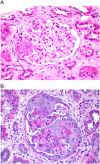A case of infection-associated antiproteinase-3-negative cytoplasmic antineutrophil cytoplasmic antibody pauci-immune focal necrotizing glomerulonephritis
- PMID: 20566570
- PMCID: PMC2948835
- DOI: 10.1093/ndt/gfq345
A case of infection-associated antiproteinase-3-negative cytoplasmic antineutrophil cytoplasmic antibody pauci-immune focal necrotizing glomerulonephritis
Abstract
We present the case of a man with Gram-negative sepsis and exposure to oral silica who developed pauci-immune focal necrotizing glomerulonephritis (PI-FNGN) in the setting of a subacute polymicrobial central venous line (CVL) infection. He developed a cytoplasmic antineutrophil cytoplasmic autoantibody (C-ANCA) that was antiproteinase-3 (PR-3) and antimyeloperoxidase (MPO) antibody negative. We believe this is the first reported case of Gram-negative sepsis-associated PI-FNGN. Chronic silica exposure is a leading environmental risk factor in the development of ANCA vasculitis. Oral silica is a common pharmaceutical additive and its bioavailability is being recognized. Oral silica, therefore, may also be a risk for development of autoreactivity. The PI-FNGN resolved with antibiotic therapy alone. The C-ANCA titer declined as the PI-FNGN resolved. The case supports experimental and observational research that environmental exposures act as adjuvants for an immune response and also provide epigenetic triggers for autoreactivity. The C-ANCA was negative for PR-3, its major antigen. C-ANCA antigen specificity may depend on the pathogenesis of the underlying disease, potentially elicited by a cross-reaction of an antibody to foreign and self target antigen sequence homology or alternatively elicited by antigenic epitope spread.
Figures

Similar articles
-
Molecular mimicry in pauci-immune focal necrotizing glomerulonephritis.Nat Med. 2008 Oct;14(10):1088-96. doi: 10.1038/nm.1874. Epub 2008 Oct 5. Nat Med. 2008. PMID: 18836458 Free PMC article.
-
Myeloperoxidase-antineutrophil cytoplasmic antibody causes different renal diseases by immune-complex formation and pauci-immune mechanism: A case report.Pathol Int. 2017 Aug;67(8):419-424. doi: 10.1111/pin.12545. Epub 2017 Jun 4. Pathol Int. 2017. PMID: 28580649
-
Myeloperoxidase antineutrophil cytoplasmic autoantibody-associated glomerulonephritis in a very elderly patient with generalized vasculitis at autopsy.Hiroshima J Med Sci. 1997 Sep;46(3):99-104. Hiroshima J Med Sci. 1997. PMID: 9353970
-
Antiproteinase 3- and antimyeloperoxidase-associated vasculitis.Kidney Int. 2000 Jun;57(6):2195-206. doi: 10.1046/j.1523-1755.2000.00080.x. Kidney Int. 2000. PMID: 10844589 Review.
-
Pathogenesis of vascular inflammation by anti-neutrophil cytoplasmic antibodies.J Am Soc Nephrol. 2006 May;17(5):1235-42. doi: 10.1681/ASN.2005101048. Epub 2006 Apr 19. J Am Soc Nephrol. 2006. PMID: 16624929 Review.
Cited by
-
Pauci-immune crescentic glomerulonephritis associated with use of trimethoprim-sulfamethoxazole.CEN Case Rep. 2016 Nov;5(2):188-191. doi: 10.1007/s13730-016-0222-5. Epub 2016 Jun 7. CEN Case Rep. 2016. PMID: 28508974 Free PMC article.
-
Glomerular disease in patients with infectious processes developing antineutrophil cytoplasmic antibodies.ISRN Nephrol. 2013 Feb 19;2013:324315. doi: 10.5402/2013/324315. eCollection 2013. ISRN Nephrol. 2013. PMID: 24959541 Free PMC article. Review.
-
Pathogenesis of antineutrophil cytoplasmic autoantibody vasculitis.Curr Opin Nephrol Hypertens. 2011 May;20(3):263-70. doi: 10.1097/MNH.0b013e3283456731. Curr Opin Nephrol Hypertens. 2011. PMID: 21422922 Free PMC article. Review.
-
Pathogenesis of ANCA-Associated Pulmonary Vasculitis.Semin Respir Crit Care Med. 2018 Aug;39(4):413-424. doi: 10.1055/s-0038-1673386. Epub 2018 Nov 7. Semin Respir Crit Care Med. 2018. PMID: 30404109 Free PMC article. Review.
References
-
- Chirinos JA, Corrales-Medina VF, Garcia S, et al. Endocarditis associated with antineutrophil cytoplasmic antibodies: a case report and review of the literature. Clin Rheumatol. 2007;26:590–595. - PubMed
-
- Kishimoto N, Mori Y, Yamahara H, et al. Cytoplasmic antineutrophil cytoplasmic antibody positive pauci-immune glomerulonephritis associated with infectious endocarditis. Clin Nephrol. 2006;66:447–454. - PubMed
-
- Fukuda M, Motokawa M, Usami T, et al. PR3-ANCA-positive crescentic necrotizing glomerulonephritis accompanied by isolated pulmonic valve infective endocarditis, with reference to previous reports of renal pathology. Clin Nephrol. 2006;66:202–209. - PubMed
-
- Peel R, Sellars L, Long ED, et al. A man with backache and renal failure. Am J Kidney Dis. 2003;41:E1. - PubMed
-
- Tervaert JW, Stegeman CA, Kallenberg CG. Silicon exposure and vasculitis. Curr Opin Rheumatol. 1998;10:12–17. - PubMed
Publication types
MeSH terms
Substances
Grants and funding
LinkOut - more resources
Full Text Sources
Research Materials
Miscellaneous

